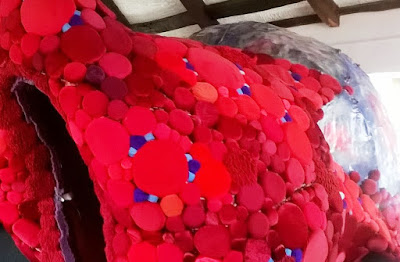The independent artists’ book HIVE IV is to be
released into the wild on Saturday 1st April 2017. The publication of the book
will coincide with an exhibition featuring each contributor’s original artwork
at The Old Brick Workshop, Wellington, Somerset, throughout the first week of
April.
The exhibition Private
View / Book Launch will take place
on Saturday 1st April, 18.00
- 20.30. A limited edition,
signed copy of the book will also be auctioned on the night.
HIVE is an ever-expanding
group of artists associated with the occasionally-published artists’
book of the same name. Since 2014 there
have been three issues of HIVE, each edited
by different artists who have also set the theme for each issue. Past themes include: ‘Track 6’, ‘The Wrong
Side of 15 Minutes’ and ‘Out of Line’. The concept of
HIVE [that has since inspired the spin-off publication SWARM] was originally initiated by artist/educator
Stuart Rosamond and artist Frank Edmunds to promote creativity and give
exposure to the work of an eclectic group of artists, photographers and
designers based in the South West and beyond. HIVE IV will feature the work of
twenty artists;
Rico Ajao, Chris Dart, Roger Dean, Frank Edmunds, Jon England, Tony Girardot, Nina Gronw-Lewis, Kevin Hawker, Martin Jackson, James Marsden, Tim Martin, Jane Mowat, Natalie Parsley, Eileen Rosamond, Stuart Rosamond, Ruby Rowswell, Chris Taylor, John Watling, Rob Watts, Deborah Westmancoat.
and the list of potential contributors to future editions is
constantly growing. HIVE IV is edited by graphic designer Rob Watts and will
feature artworks responding to the theme of ‘Lost & Found’.
Visitors are invited to celebrate the launch
of HIVE IV with the artists at the Private View of the exhibition at The Old
Brick Workshop, Wellington, Somerset, on Saturday 1st April, 18.00 - 20.30,
where they can view the original artworks from HIVE IV [Lost & Found]
created by its twenty contributing artists. This will be the first time that
contributors’ works have been publicly exhibited. During the evening there will
be a live auction when visitors can bid for a limited edition, signed copy of
HIVE IV, as one of 22 copies only ever to be produced; proceeds of which will
go towards funding future HIVE publications. The exhibition will remain open to
the public to view for free from Monday 3rd April to Saturday 8th April, open
11.00 - 16.30.
Graphics and Photo by Rob Watts
HIVE IV [Lost & Found] EXHIBITION
The Old Brick
Workshop
Higher Poole,
Wellington, Somerset TA21 9HW Monday 3rd April - Saturday 8th April 2017
Open
11.00 - 16.30
PRIVATE VIEW / BOOK LAUNCH / HIVE
AUCTION Saturday 1st April 2017 18.00 - 20.30
For further information please visit www.theoldbrickworkshop.com










